Analysis of Two New Drugs in the Japanese Pharmacopoeia Sixteenth Edition
More than 100 drugs and their analytical test methods were added to the Japanese Pharmacopoeia Sixteenth Edition, which went into effect in April 2011. Presented here is the system performance and repeatability for the methods used to analyze ta blet forms of two of the added drugs, carvedilol and glimepiride.
Carvedilol is used to treat high blood pressure and angina pectoris. It suppresses the heart rate and acts as a vasodilator by blocking α and β-receptors in the sympathetic nervous system. Glimepiride, a drug used to treat diabetes, reduces blood glucose levels by acting on the pancreas and promoting insulin secretion.
Analysis of Carvedilol Standard and Carvedilol Tablet
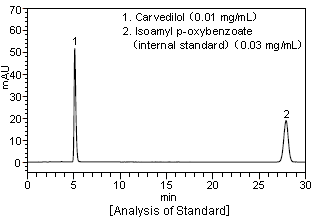
Analysis Conditions
| Column | HITACHI LaChrom C18 (5 µm) (4.6 mm I.D. × 150 mm) |
|---|---|
| Eluent | Phosphate buffer (pH 5.0)/methanol = 450/550 (v/v) |
| Flow rate | 1.0 mL/min |
| Column temperature | 40°C |
| Detection wavelength | UV 240 nm |
| Injection volume | 10 µL |
System Suitability for Carvedilol:
According to the system performance described in the Japanese Pharmacopoeia Sixteenth Edition, the resolution between carvedilol and the internal standard in the standard solution must be 20 or greater. The system repeatability, measured as the standard deviation of the area ratio for the carvedilol peak relative to the internal standard peak in the standard solution, should not be more than 1.0% (n=6).
The analytical results indicate that these requirements are met.
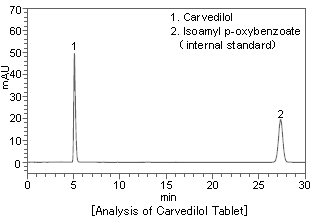
Sample Preparation Method for Carvedilol Tablet
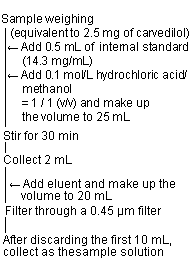
| Requirement for system suitability | Measurement result | |
|---|---|---|
| Resolution | ≥20 | 36.7 |
| Relative standard deviation of peak area ratio (n=6) |
≤1.0% | 0.075% |
* This analysis sample was provided by Division of Physical Pharmaceutical Chemistry, Faculty of Pharmacy, Keio University.
Analysis of Glimepiride Standard and Glimepiride Tablet
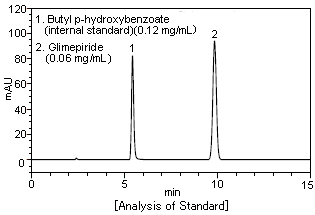
Analysis Conditions
| Column | HITACHI LaChrom C18 (5 µm) (4.6 mm I.D. × 150 mm) |
|---|---|
| Eluent | Phosphate buffer /acetonitrile = 500/500 (pH 3.5) (v/v) |
| Flow rate | 1.4 mL/min |
| Column temperature | 25°C |
| Detection wavelength | UV 228 nm |
| Injection volume | 10 µL |
System Suitability for Glimepiride:
According to the system performance described in the Japanese Pharmacopoeia Sixteenth Edition, the resolution between the glimepiride and internal standard in the standard solution must be 6 or greater. The system repeatability, measured as the standard deviation of the area ratio for the glimepiride peak relative to the internal standard peak in the standard solution, should not be more than 1.0% (n = 6).
The analytical results indicate that these requirements are met.
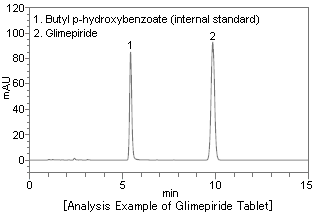
Sample Preparation Method for Glimepiride Tablet
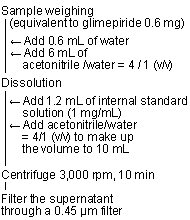
| Requirement for system suitability | Measurement result | |
|---|---|---|
| Resolution | NLT 6 | 15.2 |
| Relative standard deviation of peak area ratio (n = 6) |
NMT 1.0% | 0.077% |
NOTE:
These data are an example of measurement; the individual values cannot be guaranteed.
The system is for research use only, and is not intended for any animal or human therapeutic or diagnostic use.
In order to read a PDF file, you need to have Adobe® Reader®
